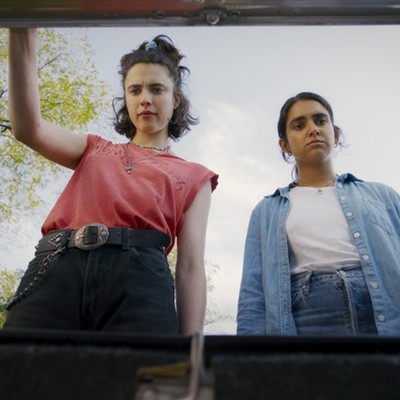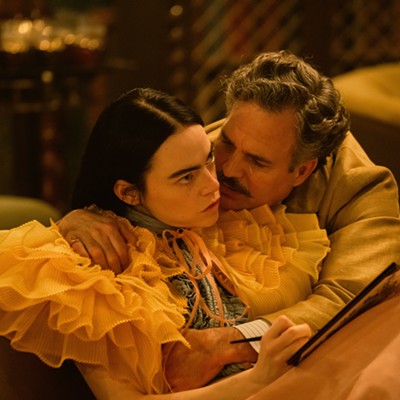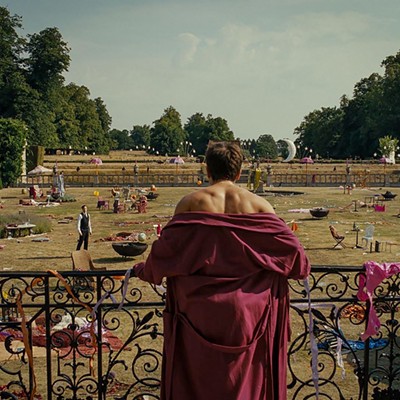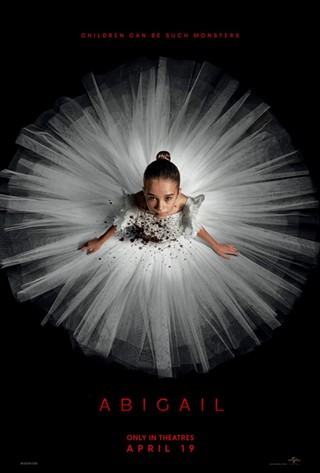Being a David Lynch film, Mulholland Drive will not appeal to everyone. Lynch's nonlinear storytelling technique and ambiguous characterizations makes Memento seem like Snow White and the Seven Dwarves. There are long, silent stretches. Scenes seem to follow each other in no particular order. Straight girls from Manitoba become Hollywood lesbians. Dwarves have long legs. Cowboys appear and disappear. Nobody kills anybody else's partner.
Or maybe they do. The story is a bit hard to summarize, in much the same way that quantum physics is a bit hard to explain to rabbits. The movie opens with a scene of swing dancers, followed by a shot of some green and red bed sheets. Pay attention ... these show up again later. Then there's a car crash, and the only survivor, a sultry, dark-haired woman, wanders down Mulholland Drive and falls asleep in an old-fashioned Hollywood bungalow.
Suffering from a concussion and amnesia, she is surprised by a fair-haired girl who's come to town to become an actress. The two bond over the search to find the dark-haired woman's identity. Meanwhile, in a seemingly unrelated story, a director is told by two Mafia types that he must cast a particular woman as the lead in his film. He is disgruntled, more so when he finds Billy Ray Cyrus in bed with his wife.
Across town, a man is horrified by the existence of a diner called Winkies. Then a low-life biker-type tries to commit a murder, and winds up killing two innocent bystanders in the funniest killing-of-innocent-bystanders scene ever filmed.
I'm pretty sure this all adds up to something, but pinning it down is a bit tough. Clearly, someone is dreaming or remembering things out of sequence. Or maybe the story is told from the perspective of the amnesiac Rita, as she slowly, and not always accurately, regains her memory. As in a dream or foggy recollection, the characters change identities, sometimes becoming each other. And yet, at no moment is the confusion a distraction from the intensely engaging story.
Partly, this works because of an incredible performance by relative unknown Naomi Watts. If they gave an award for Best Actress instead of Best Portrayal of a Likeable Character in a Politically Correct Film That Made at Least $40 Million, they'd be morally obligated to give it to Watts.
She plays Betty Elms, the innocent ingénue from up north. Or maybe she plays someone else ... or maybe the name Betty is just a name glimpsed on the name-tag of a waitress at Winkies diner. With each shift of character and situation, Watts makes such radical changes in every aspect of her performance that it seems as though four or five actresses are playing her part.
Similarly, as the sense of the plot shifts with each scene, new revelations and odd contradictions produce at least four or five viable interpretations of what's going on. This makes the film "fun," and "challenging," and "thought-provoking," and "not really well suited for American audiences."
Americans tend to like thought-provoking films that tell them exactly what to think. That's why Erin Brokovich and Philadelphia were big hits, and why great films like Music of Chance and Lynch's Lost Highway tend to die at the box office.
Lynch is aware of this, of course, so he has a backup plan in effect with Mulholland Drive. Even if the overall story doesn't seem to fit together, each individual scene is a gem. Some are hilarious, some are creepier than the creepiest of creep-out films, some are strangely touching, and all are beautifully shot.
And not beautifully shot in a way that you've seen before. Sometimes the camera drifts slowly up and down, sometimes it focuses on the strangest details of someone's face, and always the colors are intensely saturated, so much so that a monochrome background can become a disturbing focal point in an otherwise banal scene.
Combined with the amazing performance of the two leads, Watts and Laura Haring, this makes the film tremendously watchable even when it's barely comprehensible.
And, of course, this is all Lynch's doing. Not only did he write and direct Mulholland Drive, it's clear that he's calling the shots on the acting and cinematography. Everything has his signature on it, from the careful framing to the wildly variant styles of the different players.
This may be Lynch's best film; it's at least his best since Eraserhead. It has all the experimental narrative tricks that made Lost Highway a favorite of the egghead set, and all the showy glitz that made Wild at Heart a hit. It's so beautiful and sexy and unnerving that it might actually succeed at the box office. I doubt it, but I like to hope that even in America good art can bring in big bucks.










